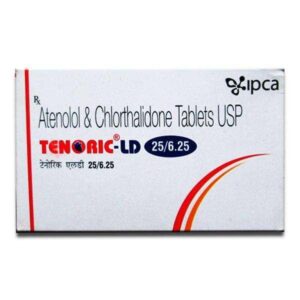ATENOLOL + CHLORTHALIDONE
Atenolol: Atenolol is a medication primarily used to treat high blood pressure (hypertension) and certain heart conditions. It belongs to a class of drugs called beta blockers, which work by blocking the effects of adrenaline on the heart and blood vessels.
The main action of Atenolol is to reduce the heart rate and force of contraction, resulting in a decrease in blood pressure. By slowing down the heart rate, it also helps to reduce the workload on the heart and improve its efficiency.
Atenolol is commonly prescribed for hypertension, angina (chest pain), and to prevent future heart attacks in patients who have had a heart attack in the past. It can also be used to manage certain types of arrhythmias (abnormal heart rhythms).
The dose of Atenolol varies depending on the condition being treated and the patient’s response to the medication. Typically, the starting dose for hypertension is 50 mg once daily, which may be increased to a maximum of 100 mg per day. For angina, the starting dose is usually 50 mg once daily, and it can be increased to a maximum of 200 mg per day.
Like any medication, Atenolol may cause side effects. Common side effects include fatigue, dizziness, cold hands or feet, and low heart rate. Some people may also experience digestive issues such as nausea, diarrhea, or stomach discomfort. It is important to note that not everyone will experience these side effects, and they are usually mild and temporary.
Less common but more serious side effects may include difficulty breathing, wheezing, swelling of the face or limbs, rash, and depression. If any of these symptoms occur, it is important to seek medical attention immediately.
Atenolol may also interact with other medications, so it is essential to inform your healthcare provider about any other drugs you are taking. Additionally, it is generally not recommended to stop taking Atenolol suddenly, as this can lead to a rapid increase in blood pressure or other symptoms. It should be discontinued under medical supervision.
As with any medication, the use of Atenolol should be carefully monitored by a healthcare professional, and regular check-ups and blood pressure measurements are necessary to ensure that the medication is working effectively and without any adverse effects.
Chlorthalidone: Chlorthalidone is a medication that belongs to the class of thiazide diuretics. It is mainly used to treat high blood pressure (hypertension) and edema (fluid retention) caused by various conditions such as heart failure, kidney disorders, or liver disease.
The mechanism of action of Chlorthalidone involves inhibiting the reabsorption of sodium and chloride ions in the kidneys. This leads to increased excretion of these ions, as well as water, resulting in a reduction of the overall fluid volume in the body. By decreasing the fluid volume, Chlorthalidone helps to lower blood pressure and relieve edema.
The usual starting dose of Chlorthalidone for hypertension is 25 mg taken once daily. Depending on the individual’s response, the dose may be increased up to a maximum of 100 mg per day. For edema, the initial dose is typically 50 to 100 mg taken once daily.
As with any medication, Chlorthalidone may cause certain side effects. Common side effects include dizziness, headache, nausea, increased urination, muscle cramps, and low blood potassium levels (hypokalemia). Some individuals may also experience allergic reactions, such as rash or itching. It is important to monitor for any signs of electrolyte imbalances, such as low sodium or magnesium levels, as well as for any worsening kidney function. In rare cases, Chlorthalidone may cause more serious side effects like pancreatitis, blood disorders, or liver problems.
It is essential to consult a healthcare professional before starting Chlorthalidone and to follow their instructions regarding dosage and monitoring. Chlorthalidone should not be used by individuals with certain medical conditions, such as severe kidney or liver disease, or allergies to sulfa medications. It may also interact with other medications, so it is important to inform the healthcare professional about all other medications being taken.

